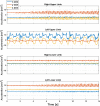Limb and trunk accelerometer data collected with wearable sensors from subjects with Parkinson's disease
- PMID: 33547317
- PMCID: PMC7864964
- DOI: 10.1038/s41597-021-00831-z
Limb and trunk accelerometer data collected with wearable sensors from subjects with Parkinson's disease
Abstract
Parkinson's disease (PD) is a neurodegenerative disorder characterized by motor and non-motor symptoms. Dyskinesia and motor fluctuations are complications of PD medications. An objective measure of on/off time with/without dyskinesia has been sought for some time because it would facilitate the titration of medications. The objective of the dataset herein presented is to assess if wearable sensor data can be used to generate accurate estimates of limb-specific symptom severity. Nineteen subjects with PD experiencing motor fluctuations were asked to wear a total of five wearable sensors on both forearms and shanks, as well as on the lower back. Accelerometer data was collected for four days, including two laboratory visits lasting 3 to 4 hours each while the remainder of the time was spent at home and in the community. During the laboratory visits, subjects performed a battery of motor tasks while clinicians rated limb-specific symptom severity. At home, subjects were instructed to use a smartphone app that guided the periodic performance of a set of motor tasks.
Conflict of interest statement
The authors declare no competing interests.
Figures




Dataset use reported in
- doi: 10.1038/s41597-021-00830-0
References
Publication types
MeSH terms
LinkOut - more resources
Full Text Sources
Other Literature Sources
Medical

